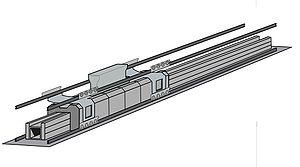Electromagnetic Aircraft Launch System
| EMALS | |

| |
| End Speed | 28–103 m/s |
| Max Peak-to-Mean Tow Force Ratio | 1.05 |
| Launch Energy | 122 MJ |
| Cycle Time | 45 seconds |
| System Weight | < 225,000 kg |
| System Volume | < 425 m³ |
| Endspeed Variation | -0 to +1.5 m/s |
The Electromagnetic Aircraft Launch System (commonly EMALS) is a system under development by the United States Navy to launch carrier-based aircraft from catapults using a linear motor drive instead of conventional steam pistons. This technology reduces stress on airframes because they can be accelerated more gradually to takeoff speed than with steam-powered catapults.
Other advantages includes lower system weight, cost, and maintenance; the ability to launch both heavier and lighter aircraft than conventional systems; and lower requirements for fresh water, reducing the need for energy-intensive desalination.
Design and development
The EMALS is being developed by General Atomics for the U.S. Navy's newest Gerald R. Ford class aircraft carriers.
In June 2010, the land-based prototype of the system passed initial tests, with the first aircraft launch from the system taking place at the end of 2010.[1]
Linear induction motor
The EMALS uses a linear induction motor (LIM), which uses electric currents to generate magnetic fields that propel a carriage down a track to launch the aircraft.[2] The EMALS consists of four main elements:[3] The linear induction motor consists of a row of stator coils that have the function of a conventional motor’s rotor. When energized, the motor accelerates the carriage down the track. Only the section of the coils surrounding the carriage is energized at any given time, minimizing reactive losses. The EMALS' 300-foot (91 m) LIM will accelerate a 100,000-pound (45,000 kg) aircraft to 130 knots (240 km/h).[2]
Energy storage subsystem
The induction motor requires a large amount of electric energy in just a few seconds — more than the ship's own power source can provide. EMALS' energy-storage subsystem draws power from the ship and stores it kinetically on rotors of four disk alternators.[4] Each rotor can store more than 100 megajoules, and can be recharged within 45 seconds of a launch, faster than steam catapults.[2]
Power conversion subsystem
During launch, the power conversion subsystem releases the stored energy from the disk alternators using a cycloconverter.[2] The cycloconverter provides a controlled rising frequency and voltage to the LIM, energizing only the small portion of stator coils that affect the launch carriage at any given moment.[4]
Control consoles
Operators control the power through a closed loop system. Hall effect sensors on the track monitor its operation, allowing the system to ensure that it provides the desired acceleration. The closed loop system allows the EMALS to maintain a constant tow force, which helps reduce the launch stresses on the plane’s airframe.[2]
Program status

- 18 December 2010: Successful launch of a F/A-18E Super Hornet at Naval Air Engineering Station Lakehurst.[5][6]
- 1–2 June 2010: Successful launch of a T-45 Goshawk at Naval Air Engineering Station Lakehurst.[7]
- 9–10 June 2010: Successful launch of a C-2 Greyhound at Naval Air Engineering Station Lakehurst.[8]
- 27 September 2011: Successful launch of a E-2D Advanced Hawkeye at Naval Air Engineering Station Lakehurst.[9][10]
- 18 November 2011: Successful launch of a F-35C Lightning II.[11]
Advantages
Compared to steam catapults, EMALS weighs less, occupies less space, requires less maintenance and manpower, is more reliable, and uses less energy. Steam catapults, which use about 614 kilograms of steam per launch, have extensive mechanical, pneumatic, and hydraulic subsystems.[4] EMALS uses no steam, which makes it suitable for the Navy's planned all-electric ships.[12] The EMALS could be more easily incorporated into a ramp, which would reduce the aircraft's takeoff speed and consequently the launch energy required.[4]
Compared to steam catapults, EMALS can control the launch performance with greater precision, allowing it to launch more kinds of aircraft, from heavy fighter jets to light unmanned aircraft.[12] EMALS can also deliver 29 percent more energy than steam's approximately 95 megajoules, increasing the output to 122 megajoules.[4] The EMALS will also be more efficient than the 5-percent efficiency of steam catapults.[2]
Systems to use EMALS
EMALS is a design feature of the Ford class carrier.[13]
Converteam UK were working on a electro-magnetic catapult (EMCAT) system for the Queen Elizabeth-class aircraft carrier.[14] In August 2009, speculation mounted that the UK may drop the STOVL F-35B for the CTOL F-35C model, which would have meant the carriers being built to operate conventional (CV) take off and landing aircraft utilizing the UK-designed non-steam EMCAT catapults.[15][16]
In October 2010, the UK Government announced it had opted to buy the F-35C, using a then-undecided CATOBAR system. A contract was signed in December 2011 with the General Atomics Company of San Diego to develop EMALS for the Queen Elizabeth-class carriers. However, in May 2012, the UK Government reversed its decision after the projected costs rose to double the original estimate and delivery moved back to 2023, cancelling the F-35C option and reverting to its original decision to buy the STOVL F-35B.
See also
References
- ^ "Carrier Launch System Passes Initial Tests". Aviation Week. 7 June 2010.
- ^ a b c d e f Schweber, Bill (11 April 2002). "How It Works" (PDF). EDN Magazine. Retrieved 18 February 2008.
- ^ http://www.ga.com/atg/EMS/m1346.php
- ^ a b c d e Doyle, Samuel, Conway, and Klimowski (15 April 1994). "Electromagnetic Aircraft Launch System - EMALS" (PDF). Retrieved 14 January 2009.
{{cite news}}: CS1 maint: multiple names: authors list (link) - ^ http://www.navair.navy.mil/NewsReleases/index.cfm?fuseaction=home.view&id=4468
- ^ "USN undertakes first EMALS Hornet launch". Air Forces Monthly (Issue 275). Key Publishing Ltd: page 18. March 2011. ISSN 0955-7091.
{{cite journal}}:|access-date=requires|url=(help);|issue=has extra text (help);|pages=has extra text (help) - ^ http://www.navair.navy.mil/index.cfm?fuseaction=home.NAVAIRNewsStory&id=4620
- ^ http://www.navair.navy.mil/index.cfm?fuseaction=home.NAVAIRNewsStory&id=4623
- ^ "Navy's new electromagnetic catapult 'real smooth'". Newbury Park Press. 28 September 2011. Retrieved 4 October 2011.
{{cite web}}: Italic or bold markup not allowed in:|publisher=(help) - ^ "New carrier launch system tested". Security Industry. UPI. 3 October 2011. Retrieved 4 October 2011.
- ^ "F-35C launches from emals".
- ^ a b Lowe, Christian. "Defense Tech: EMALS: Next Gen Catapult". Retrieved 27 February 2008.
- ^ AVIATIONWEEK.COM Carrier Launch System Passes Initial Tests
- ^ "Converteam develops catapult launch system for UK carriers" By Tim Fish, Jane's. 26 July 2010
- ^ "Britain rethinks jump jet order". UPI.com. 12 August 2009. Retrieved 14 August 2009.
- ^ Harding, Thomas (5 August 2009). "Defence jobs at risk". London: Telegraph.co. Retrieved 14 August 2009.
External links
- "Electromagnetic Aircraft Launch System - EMALS", GlobalSecurity.org
